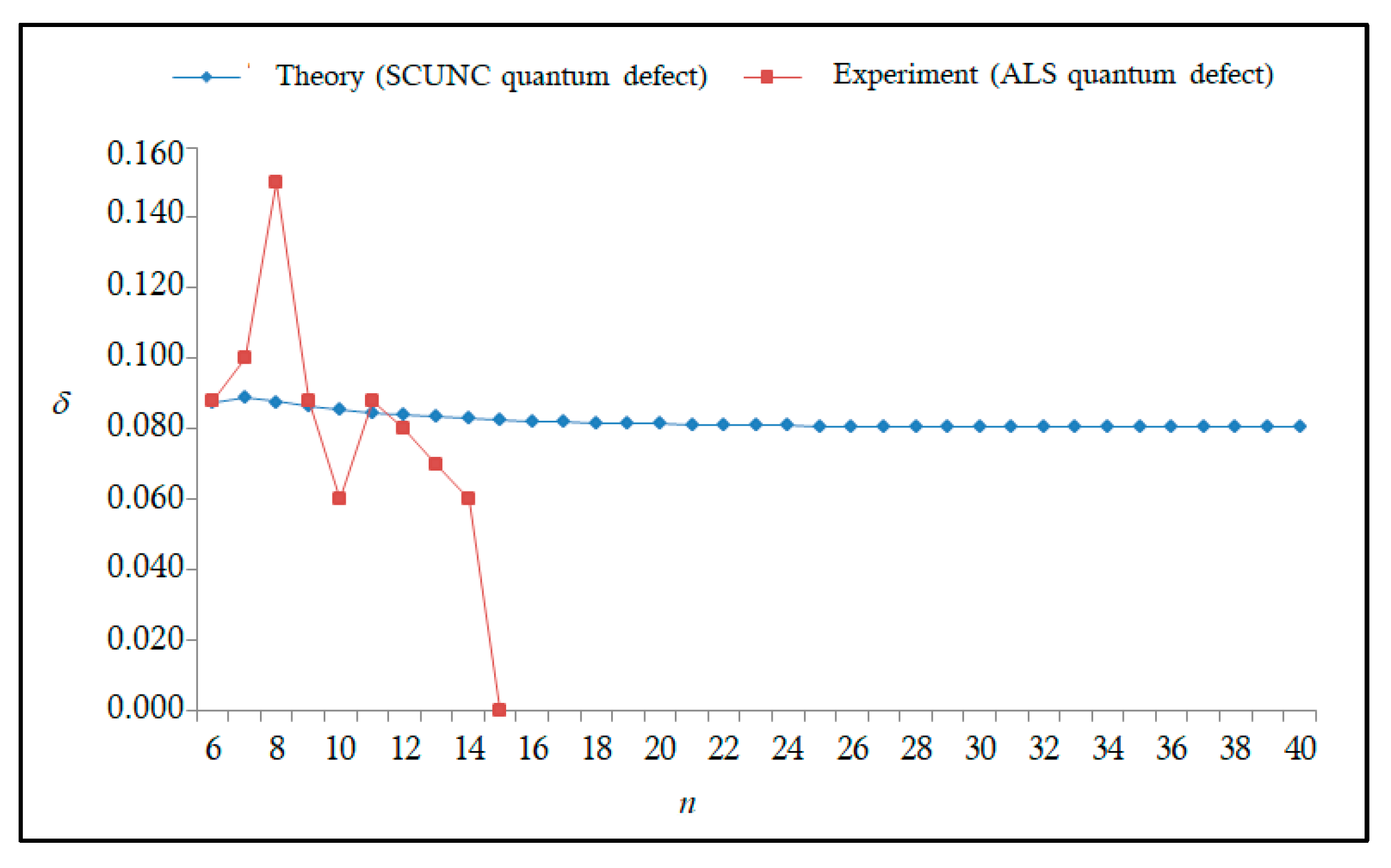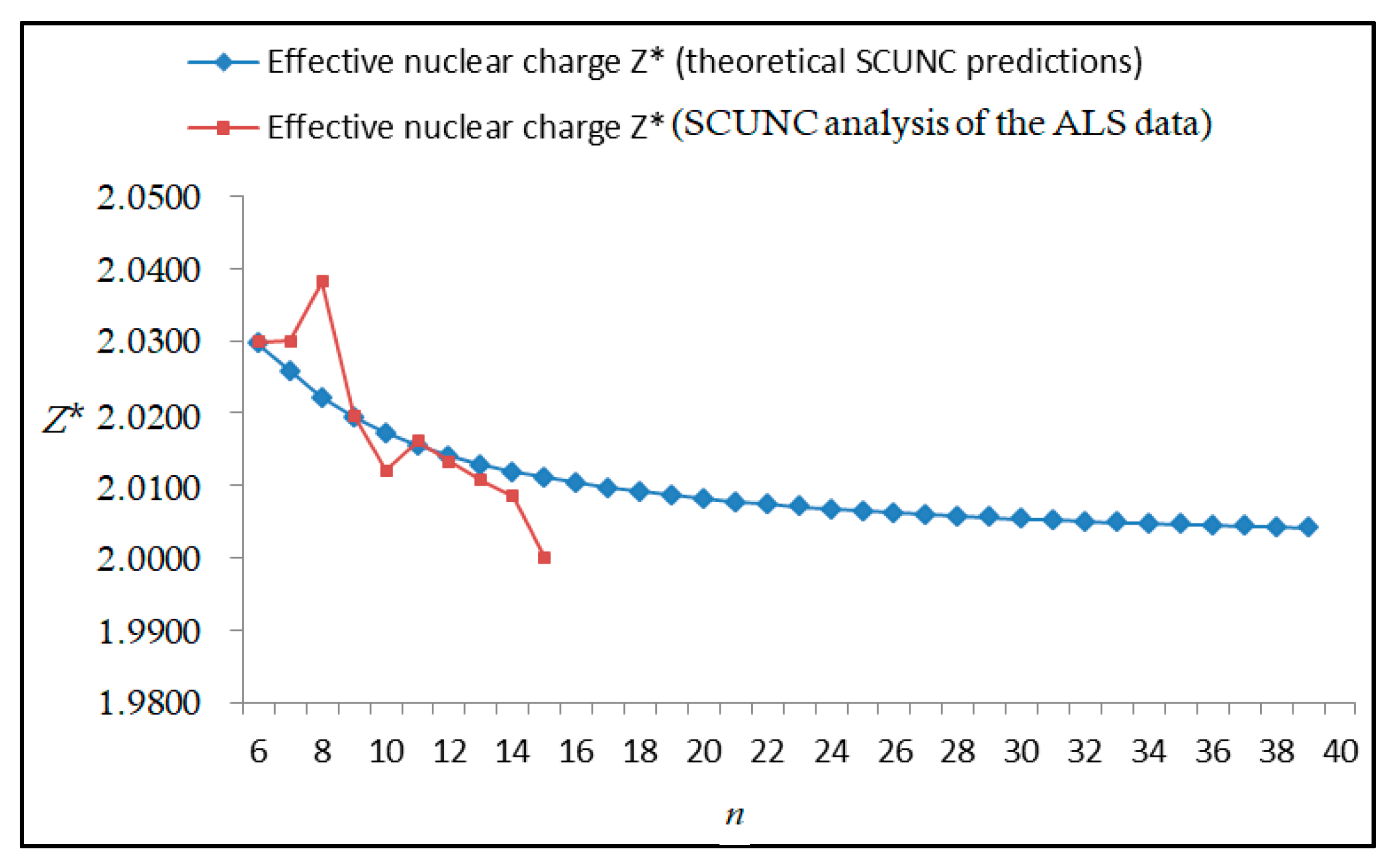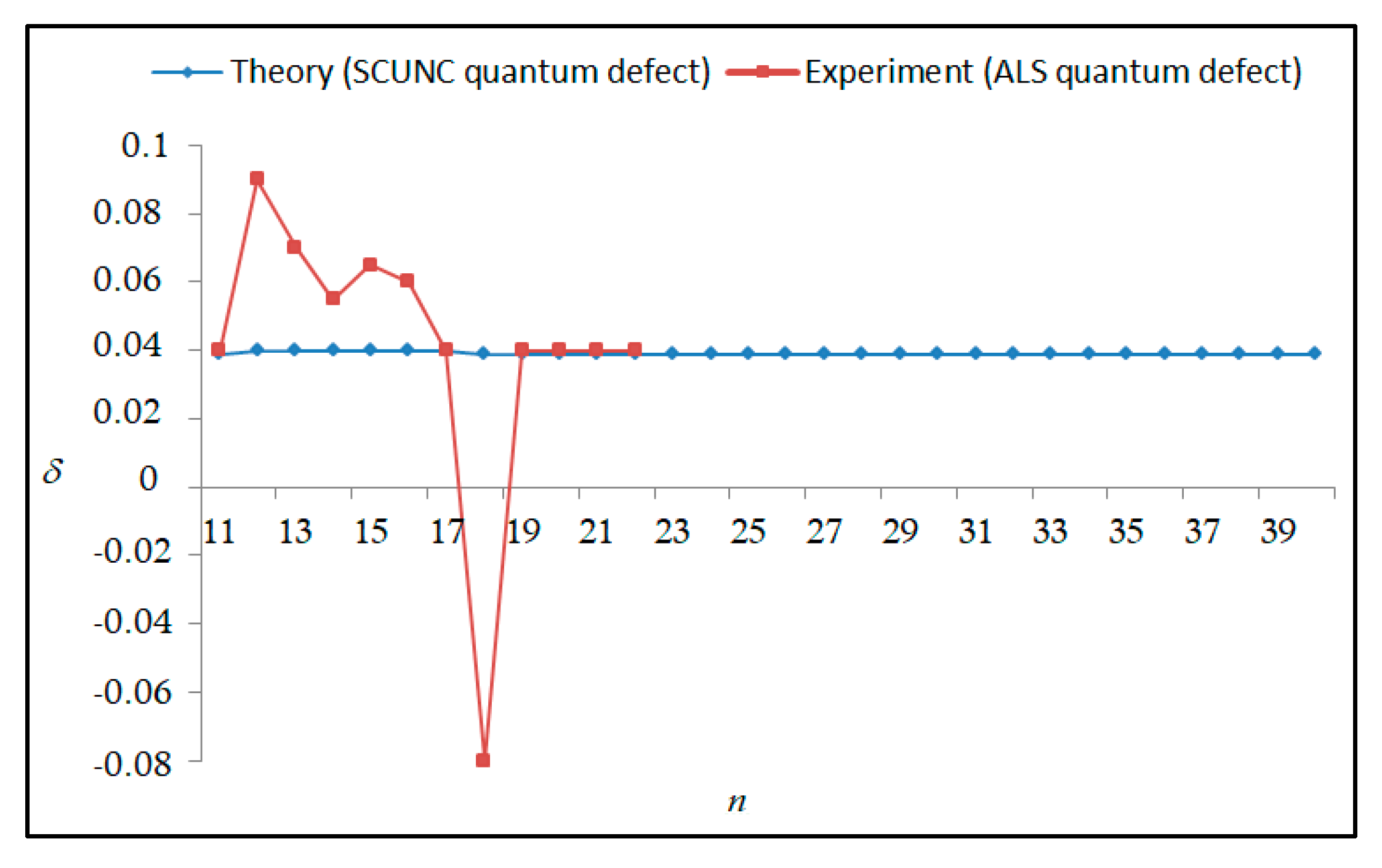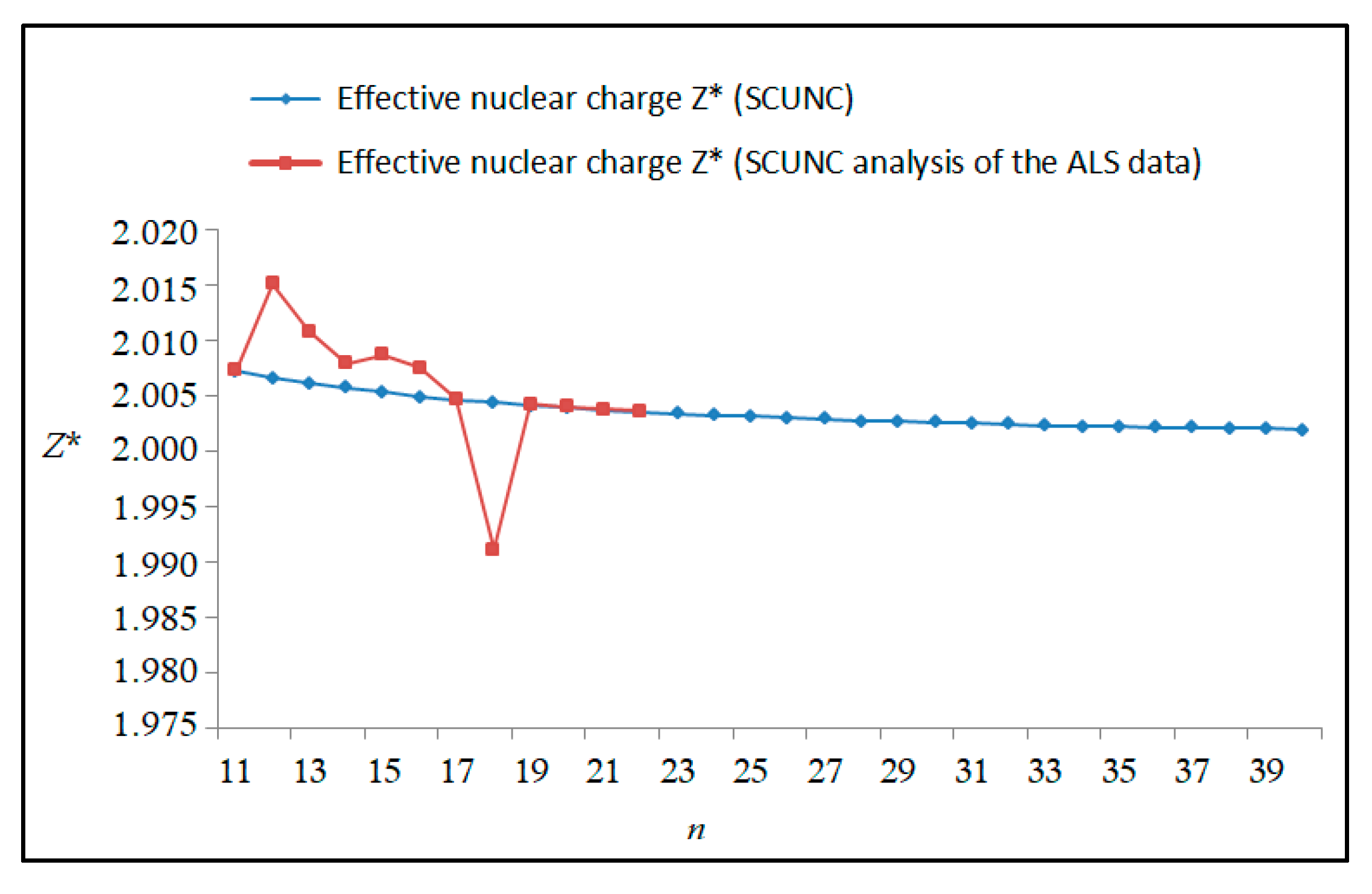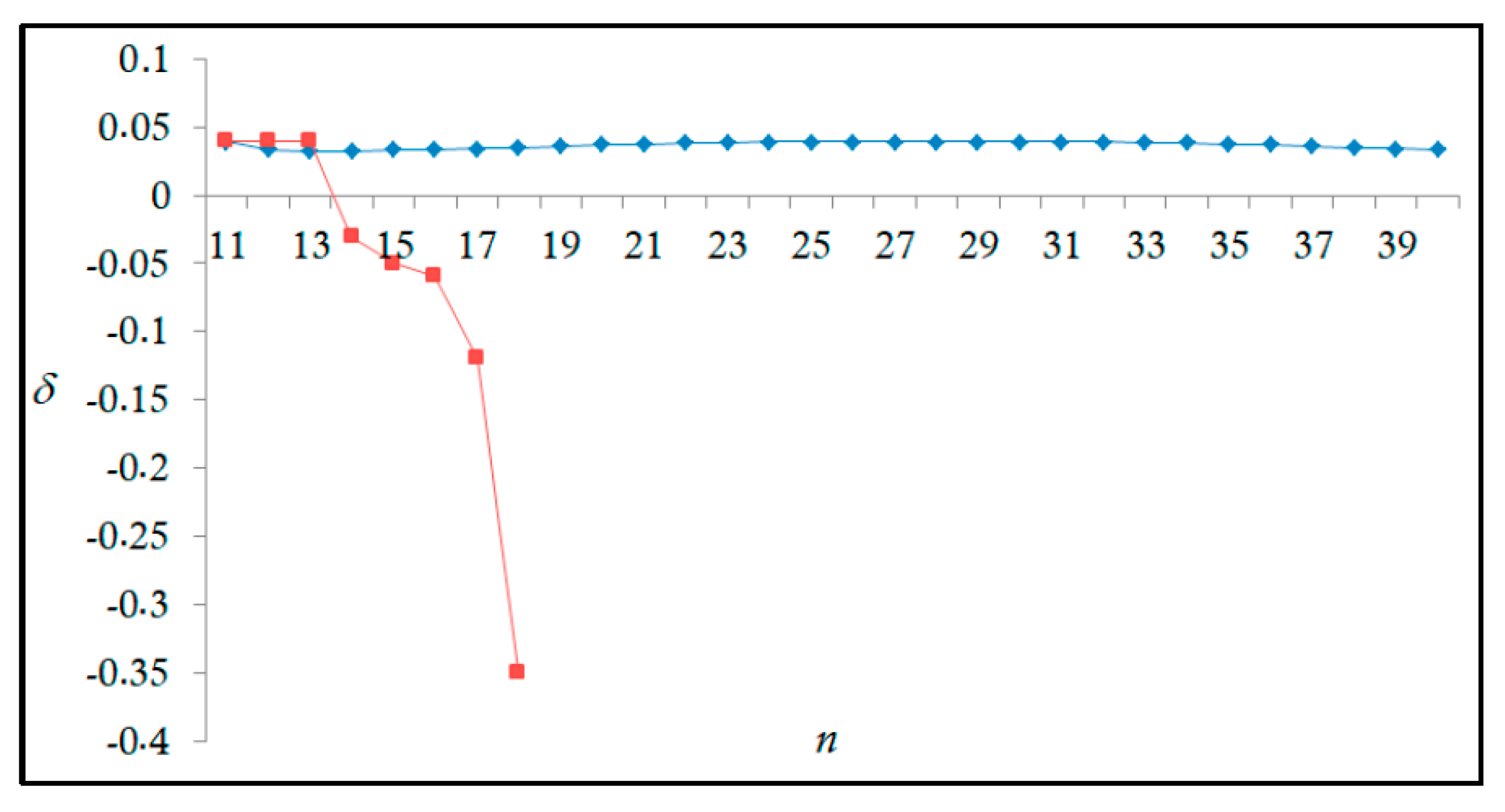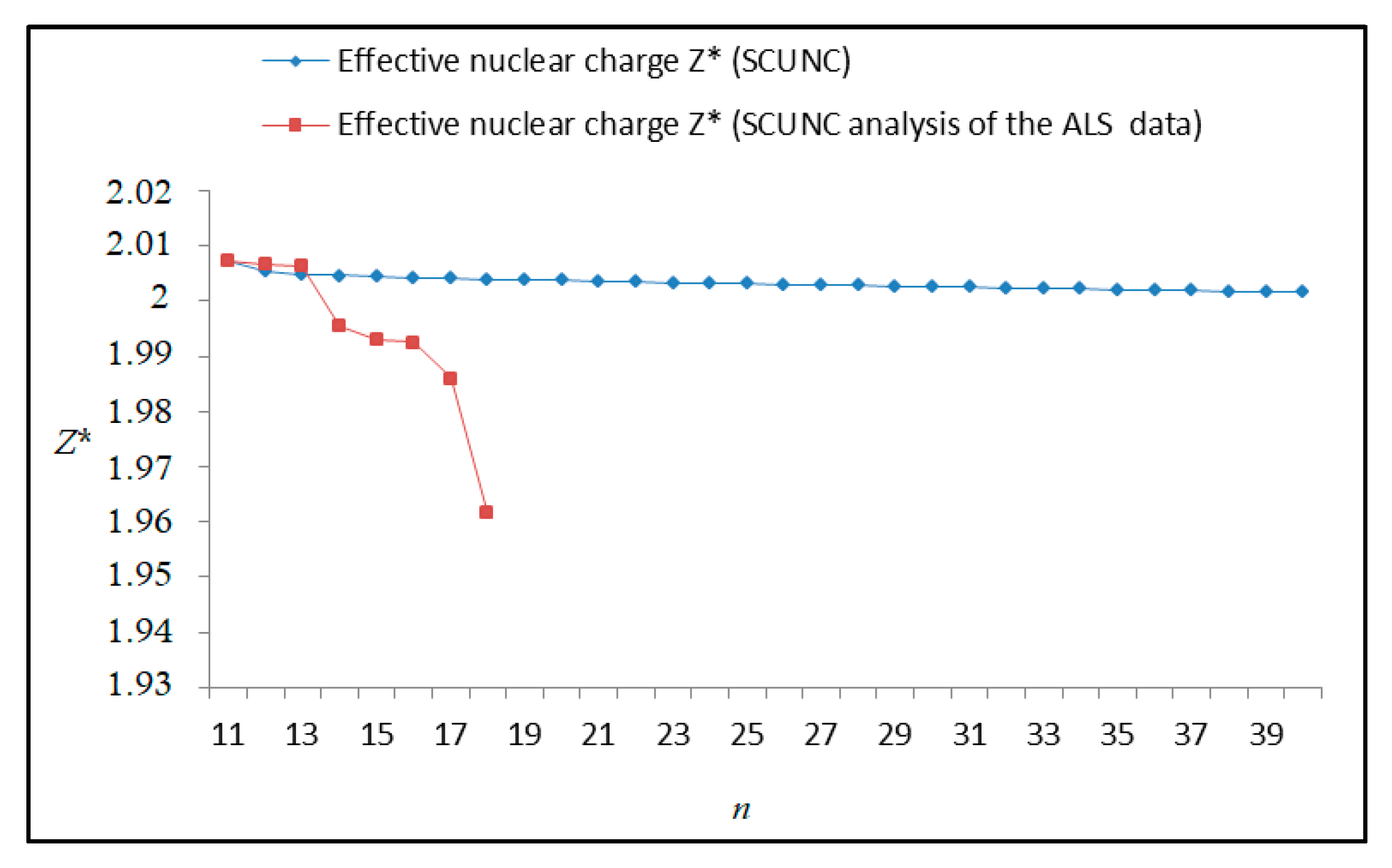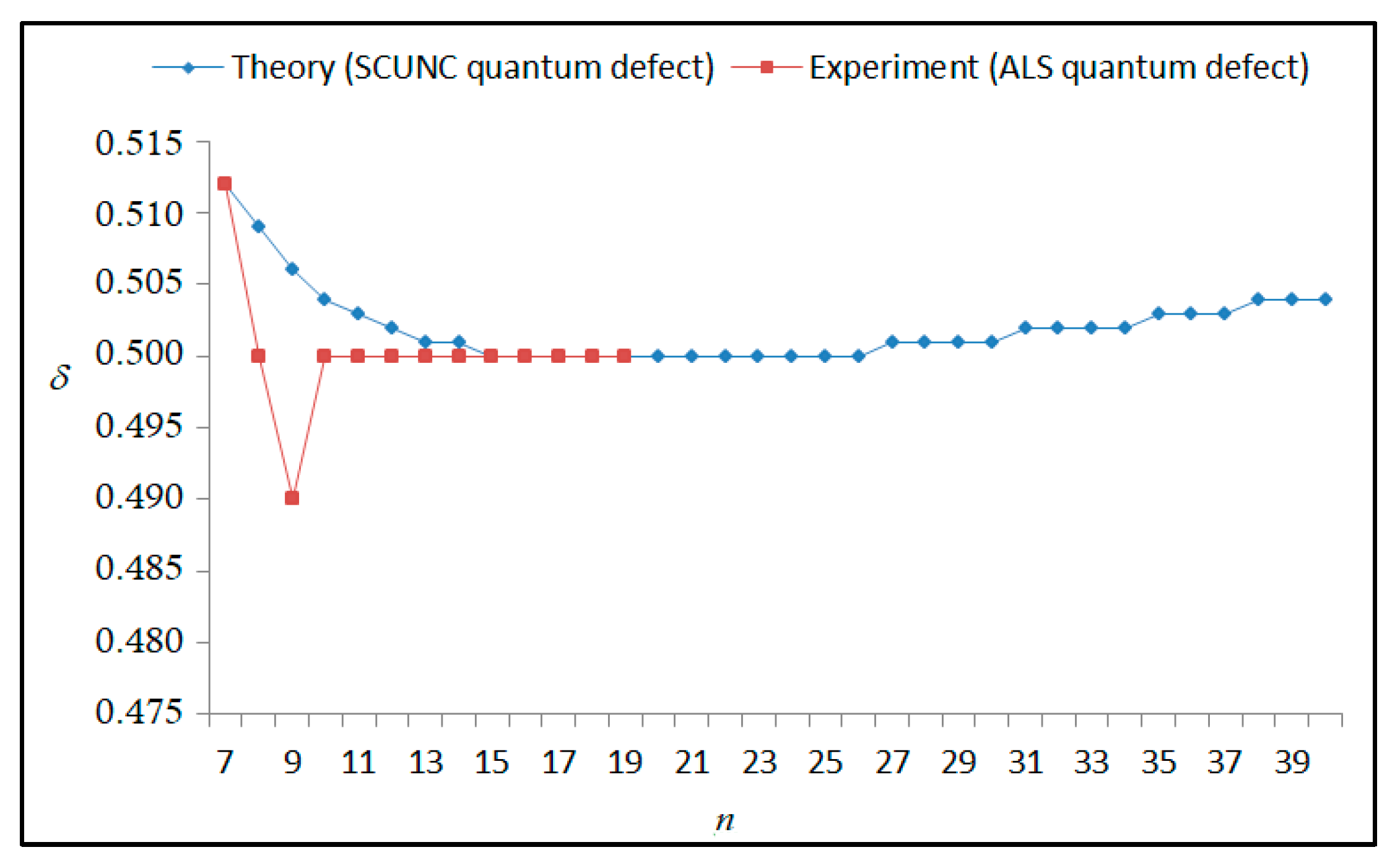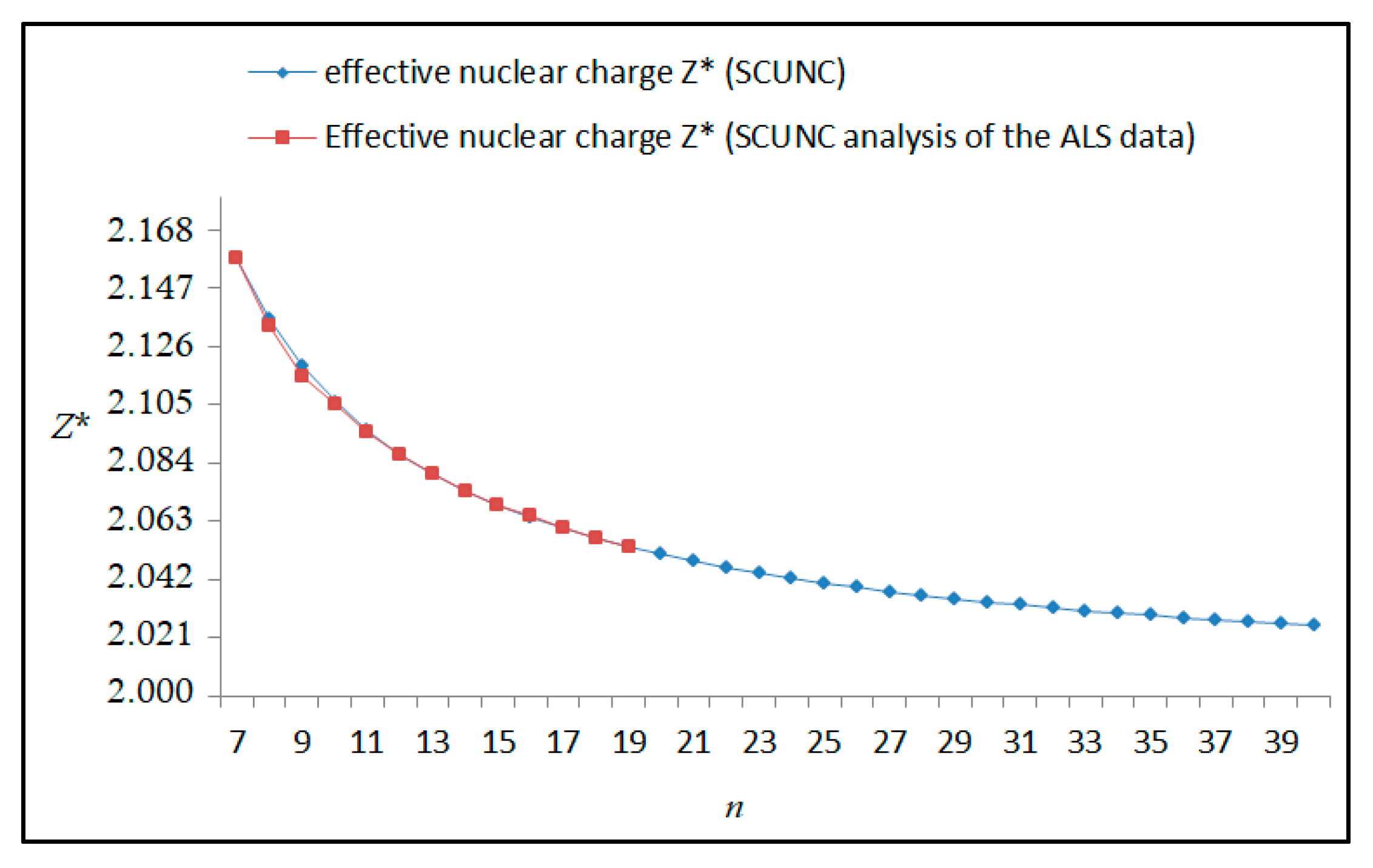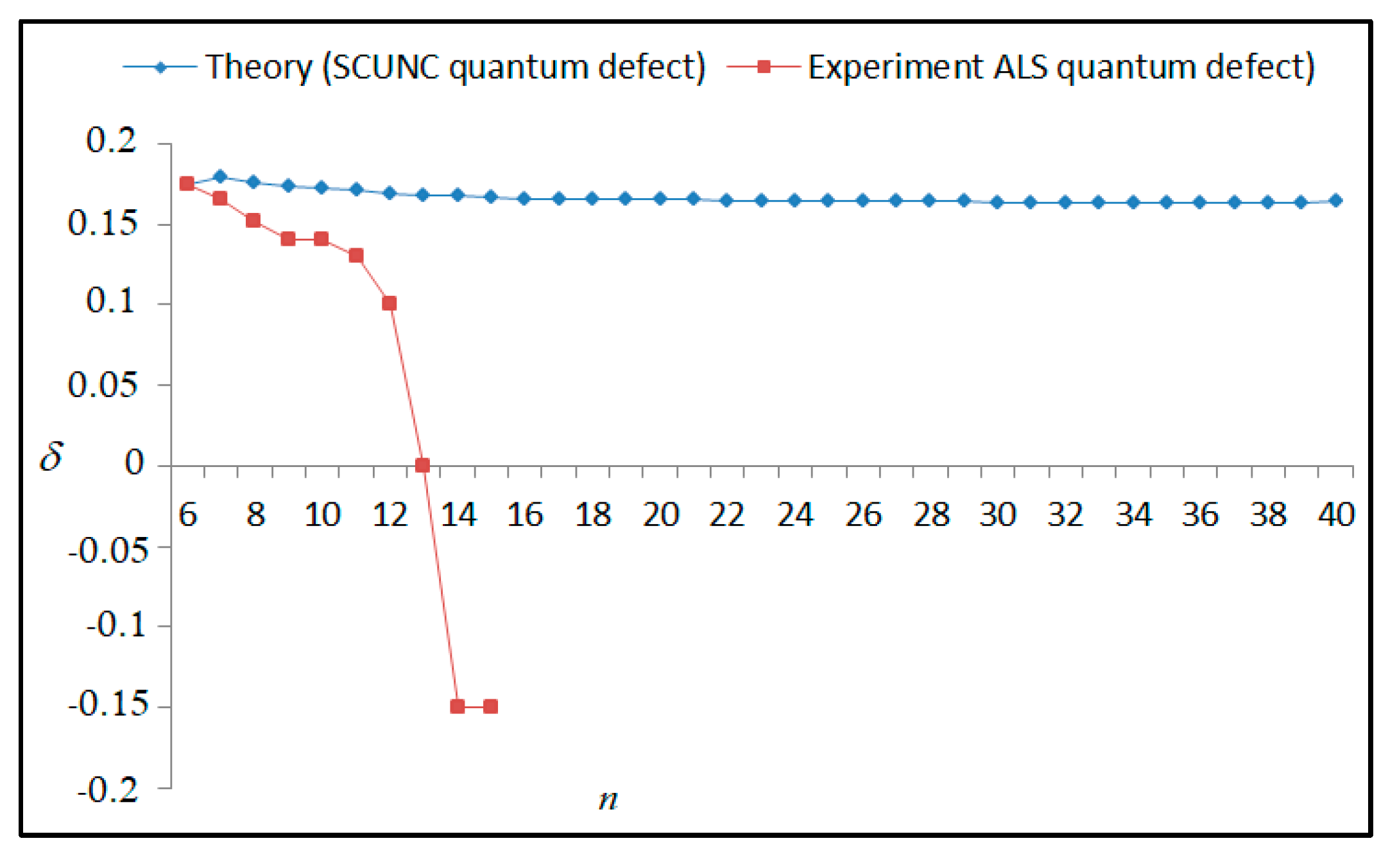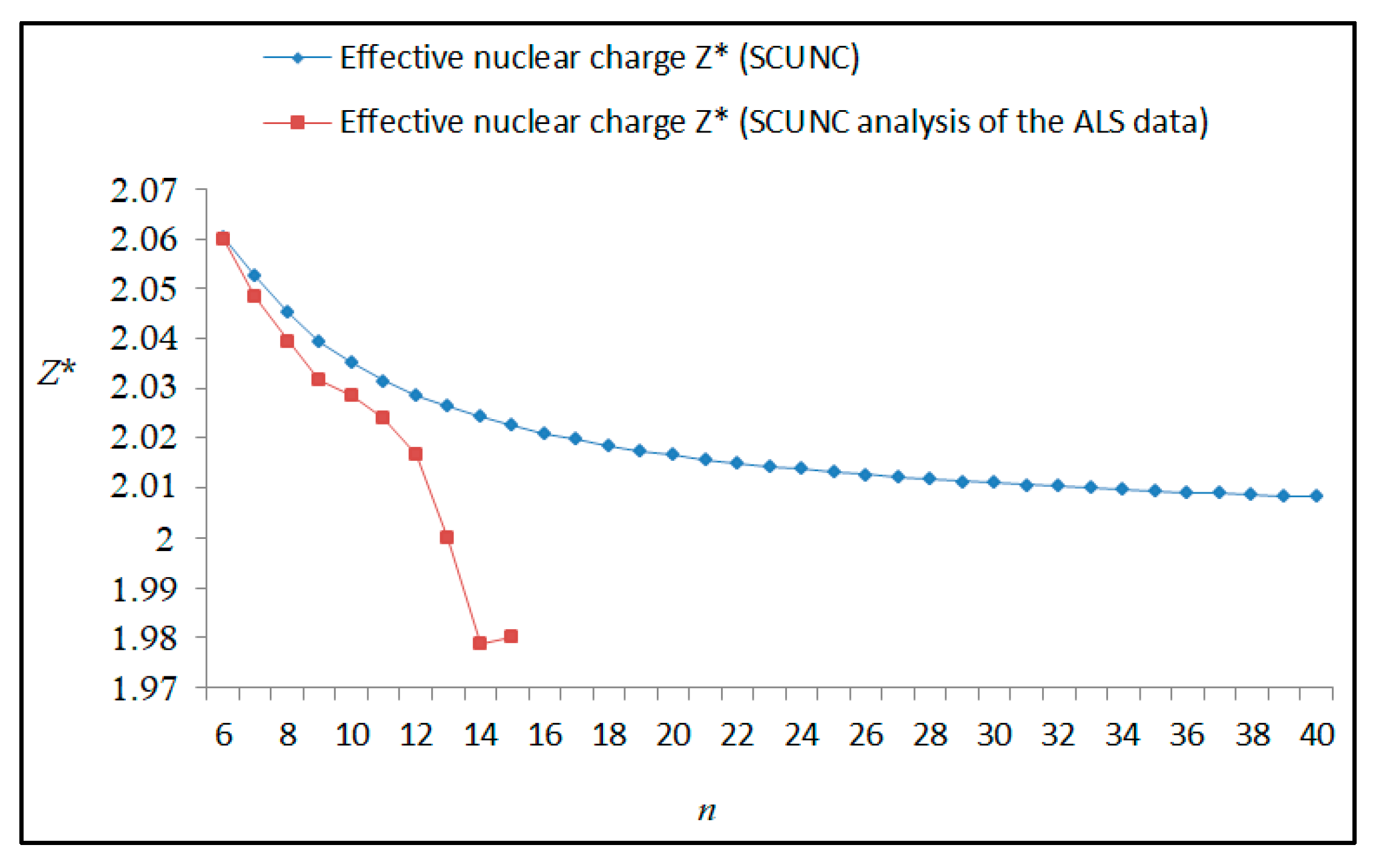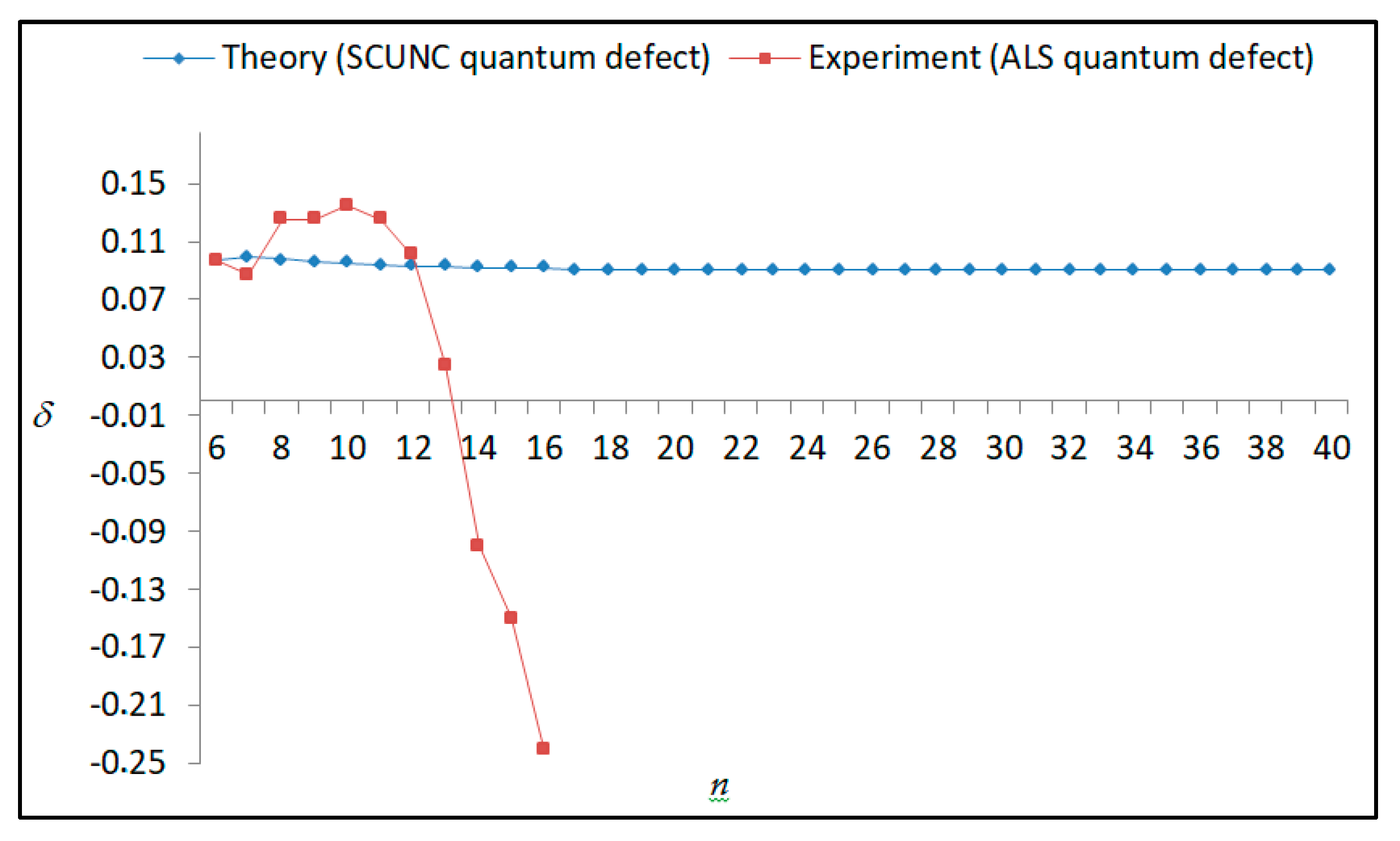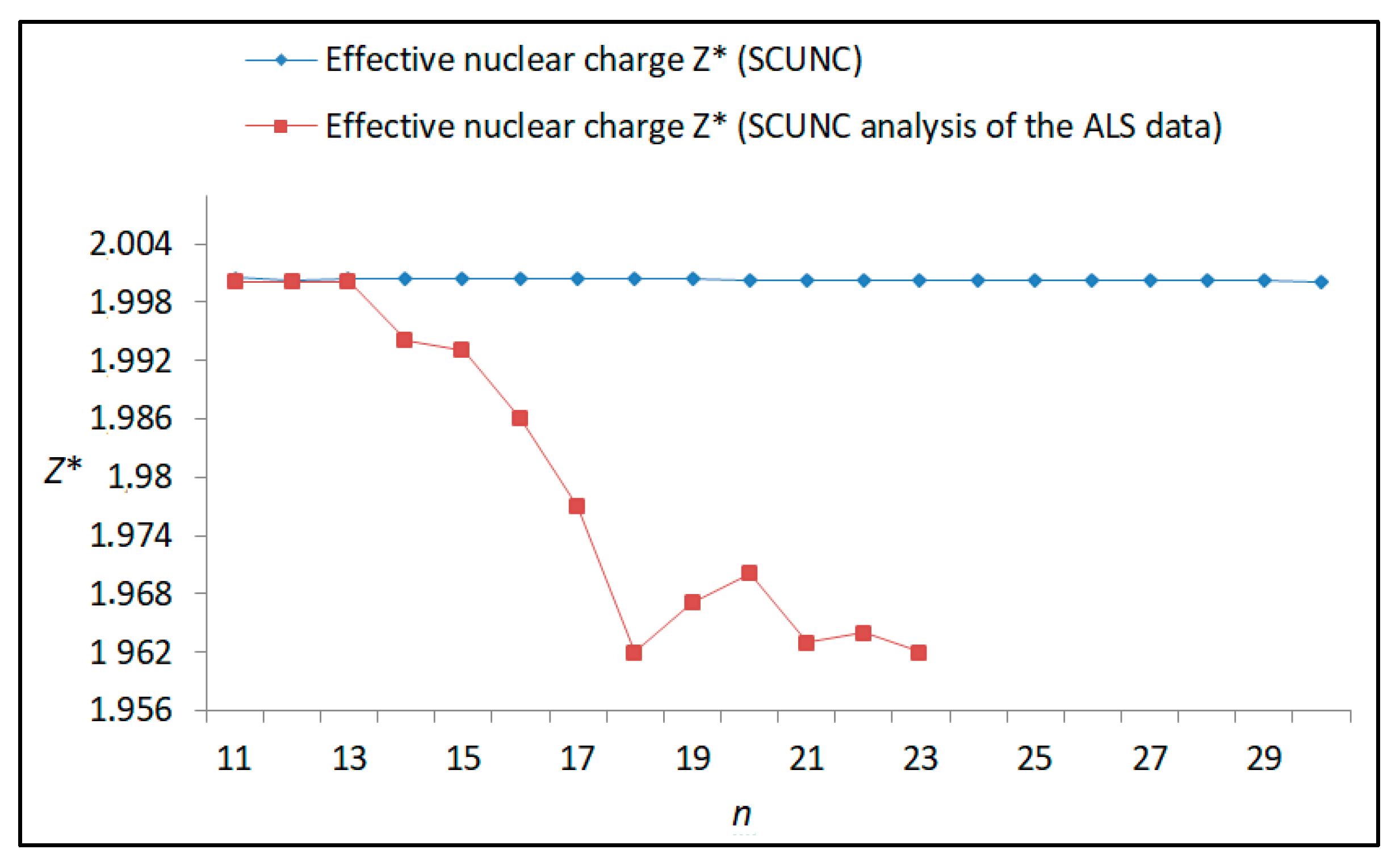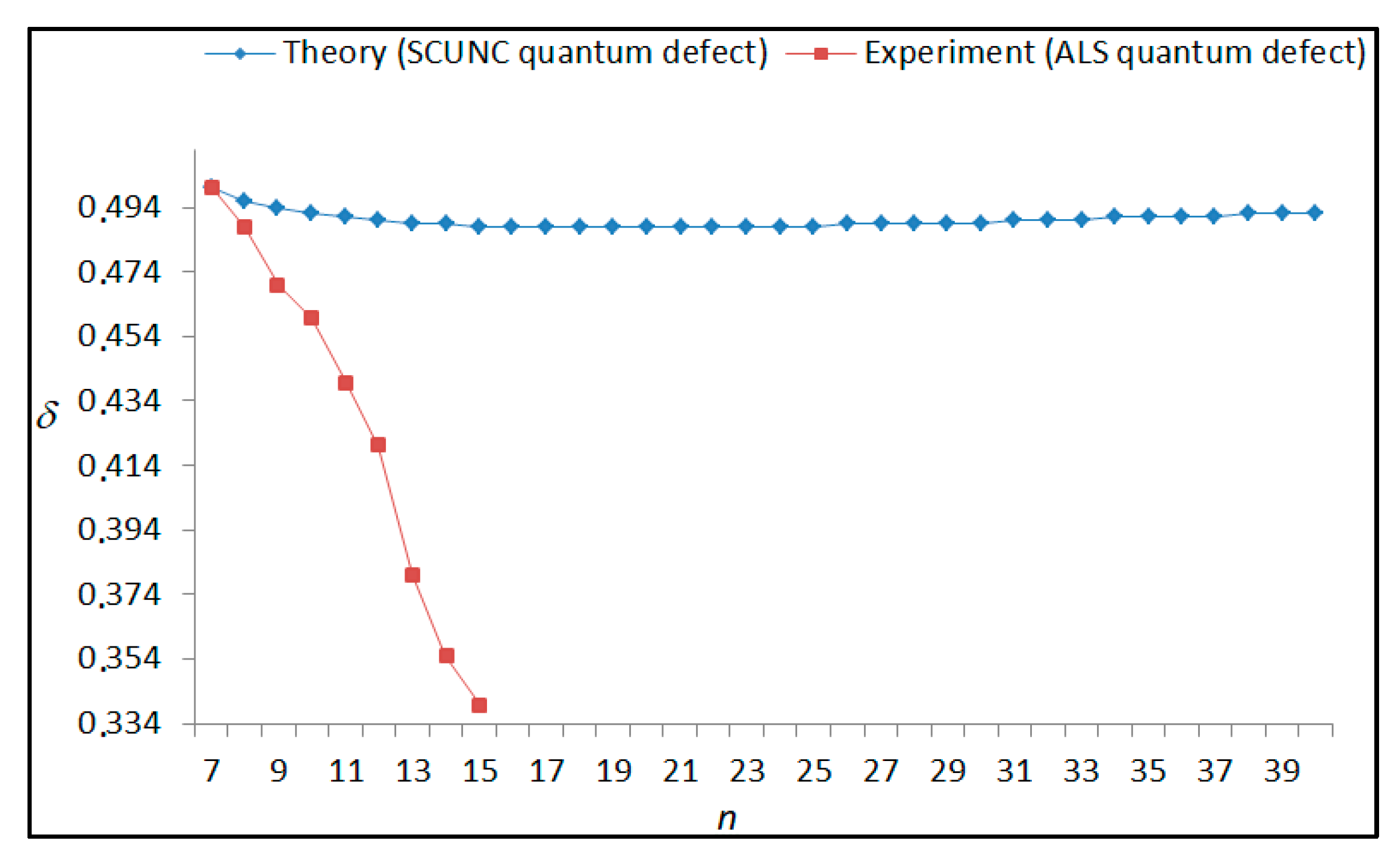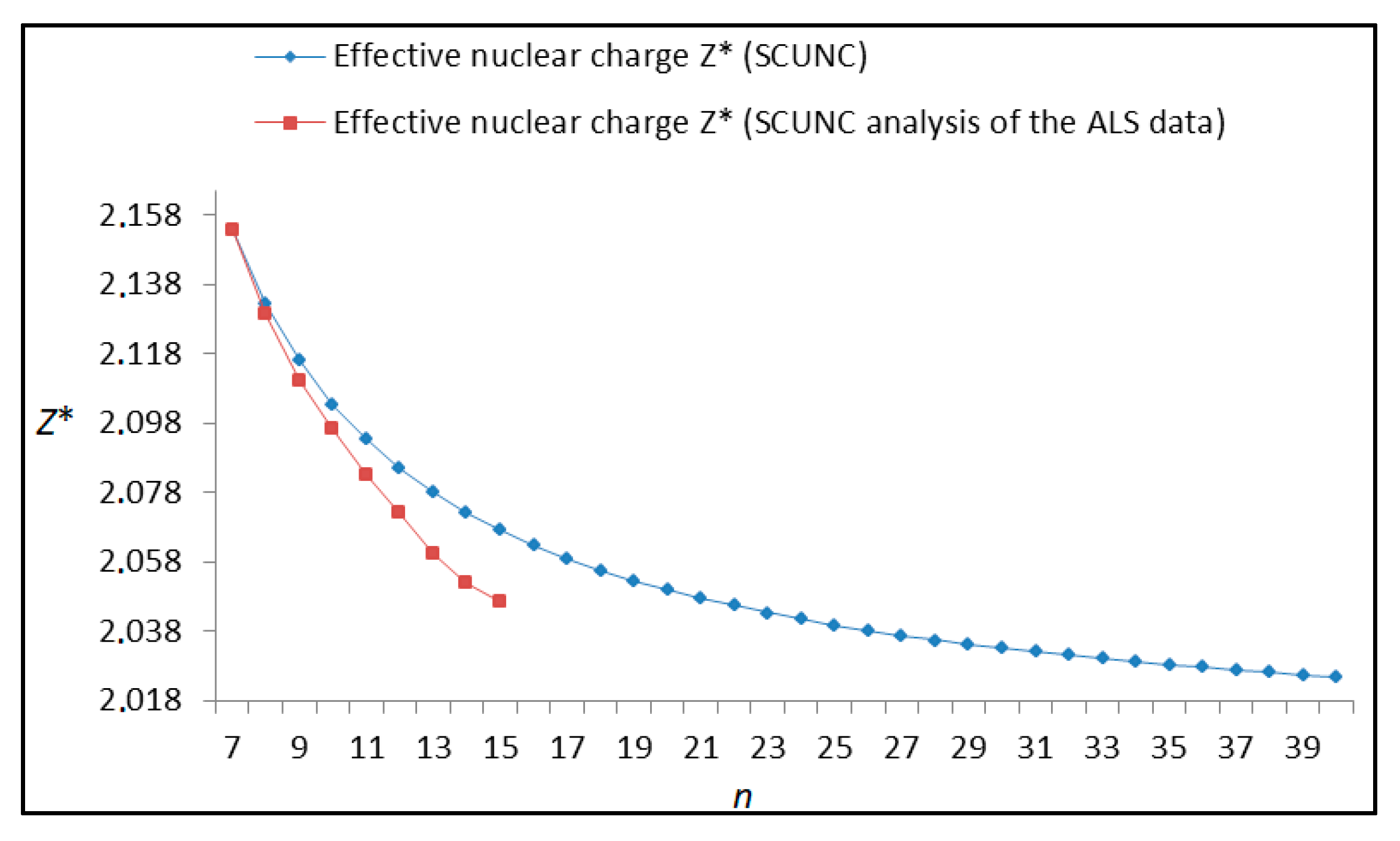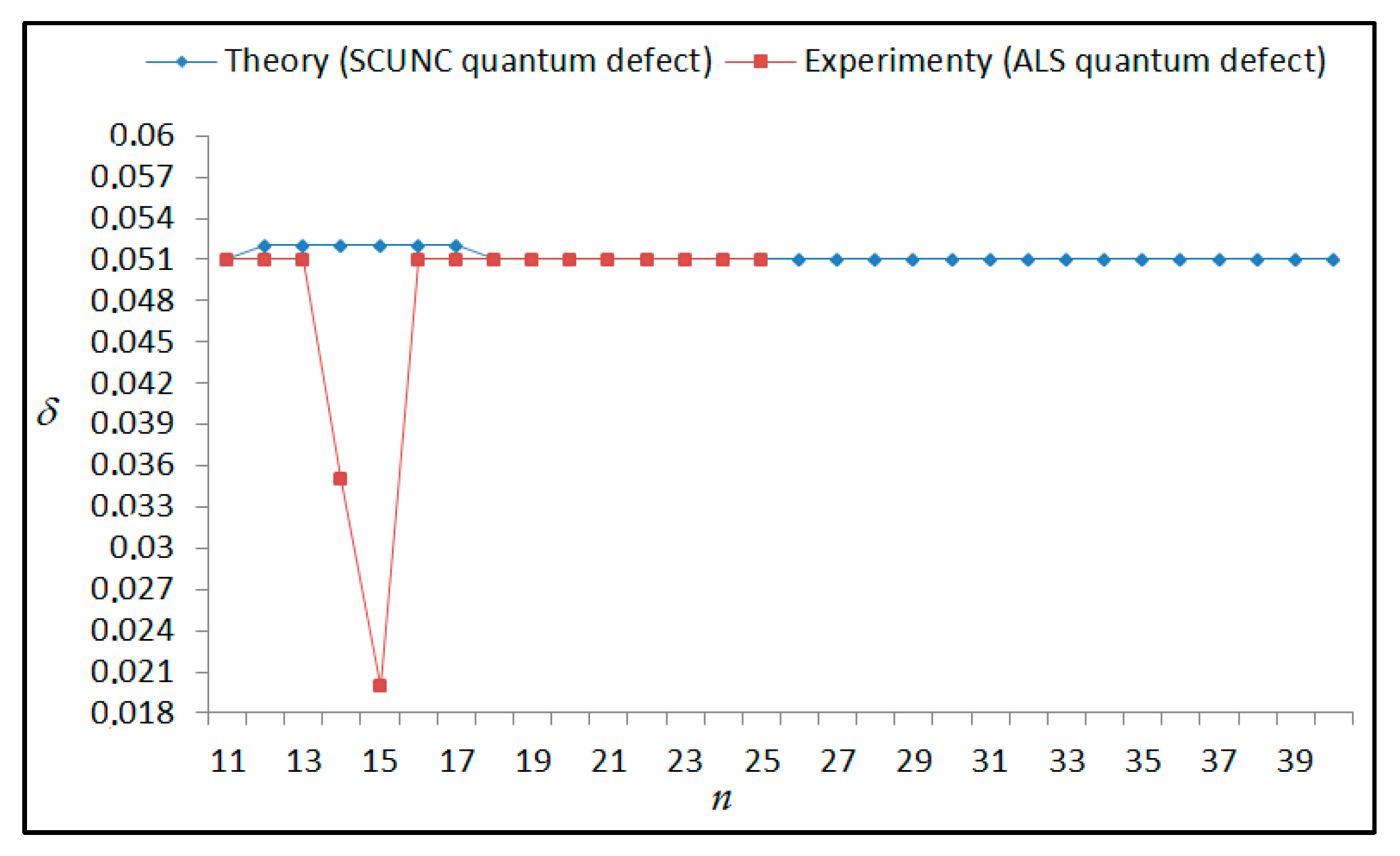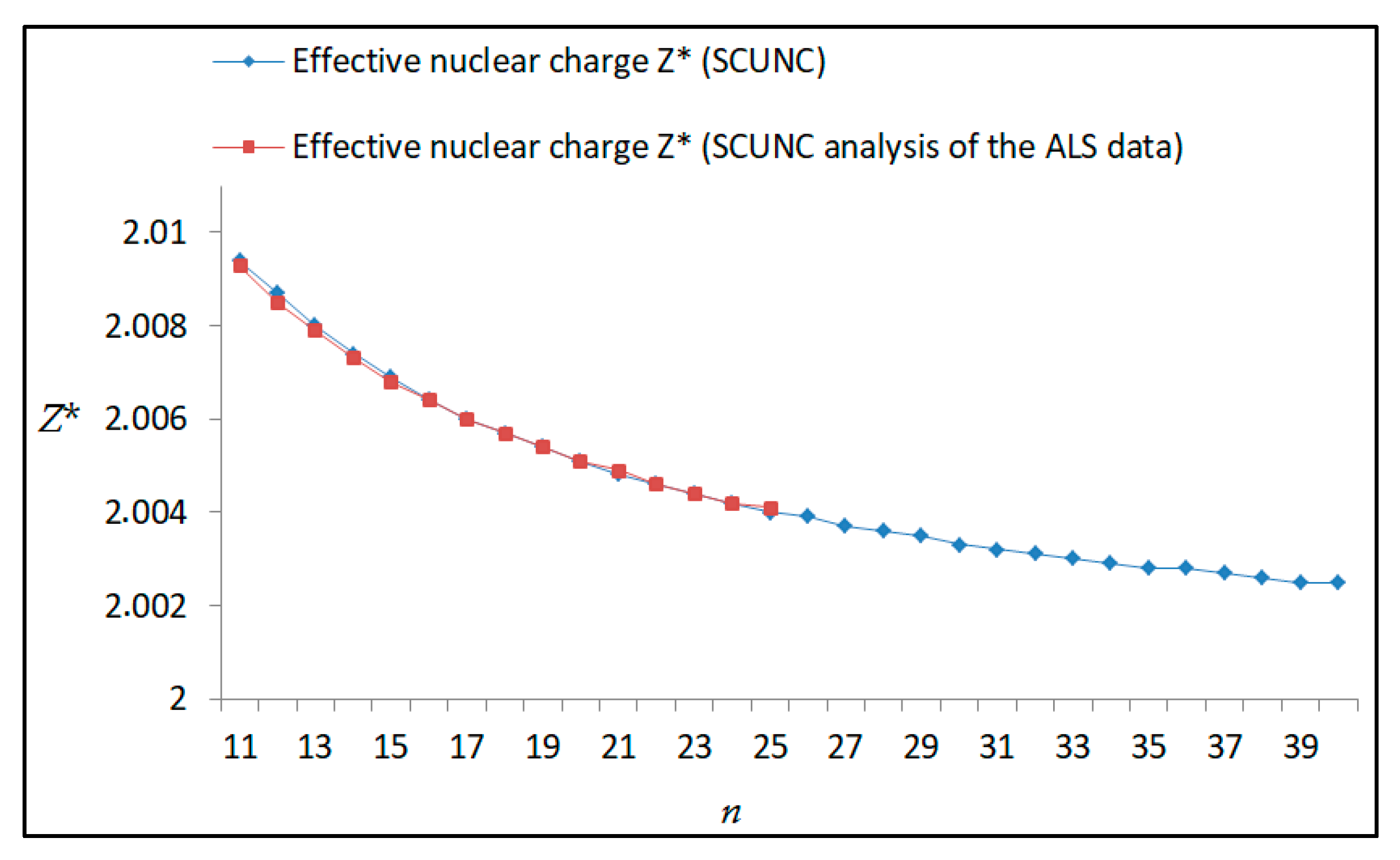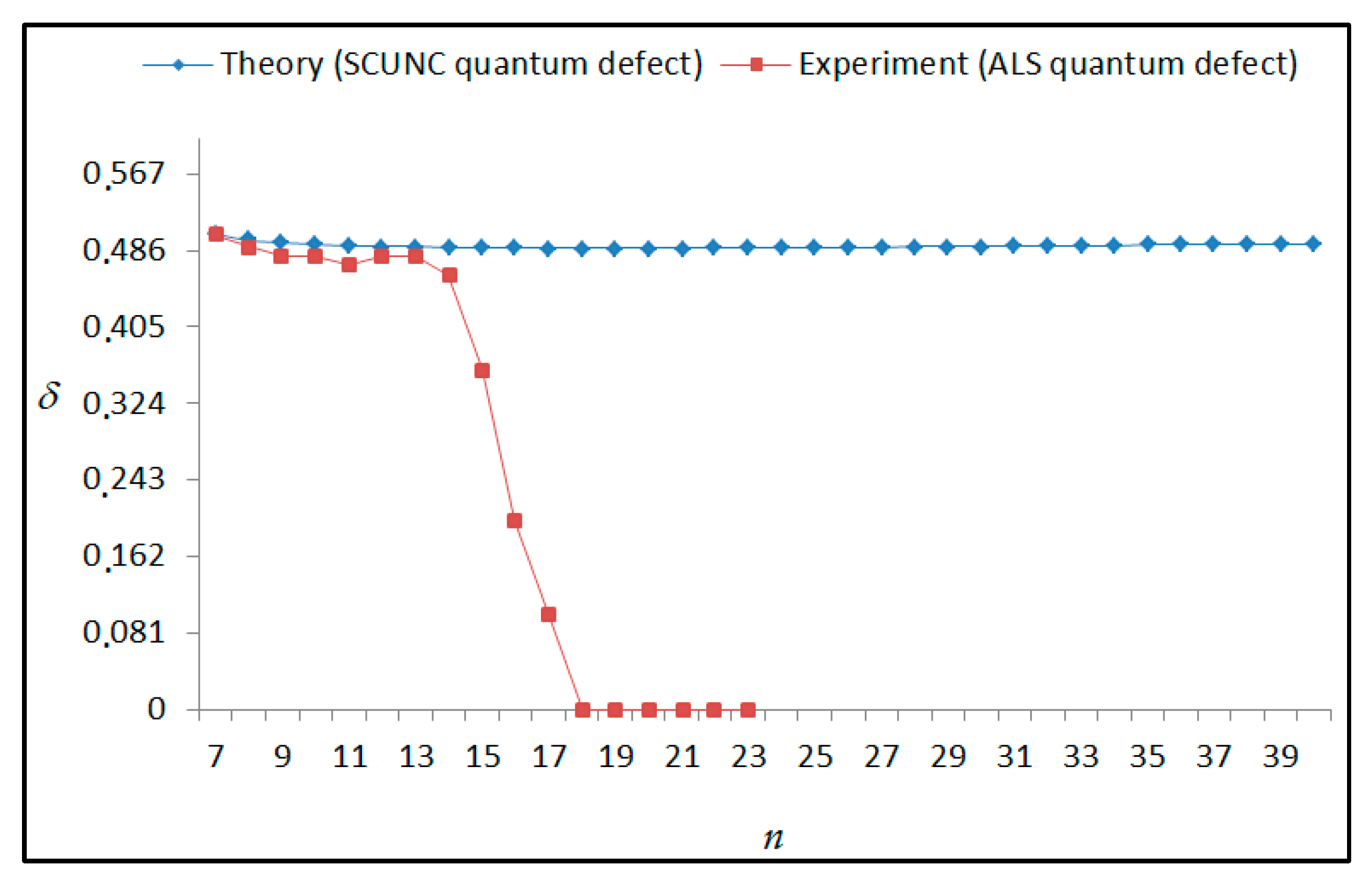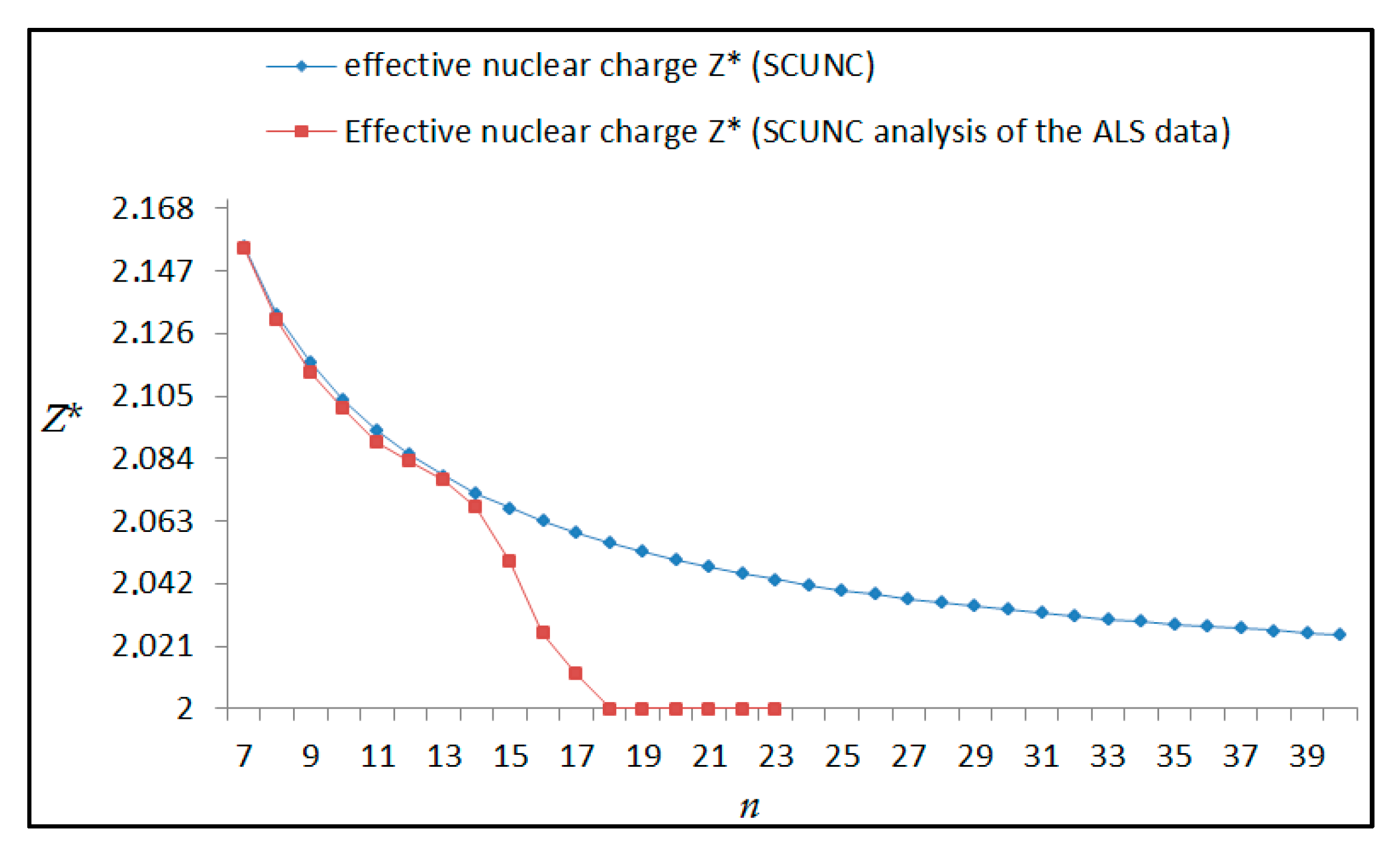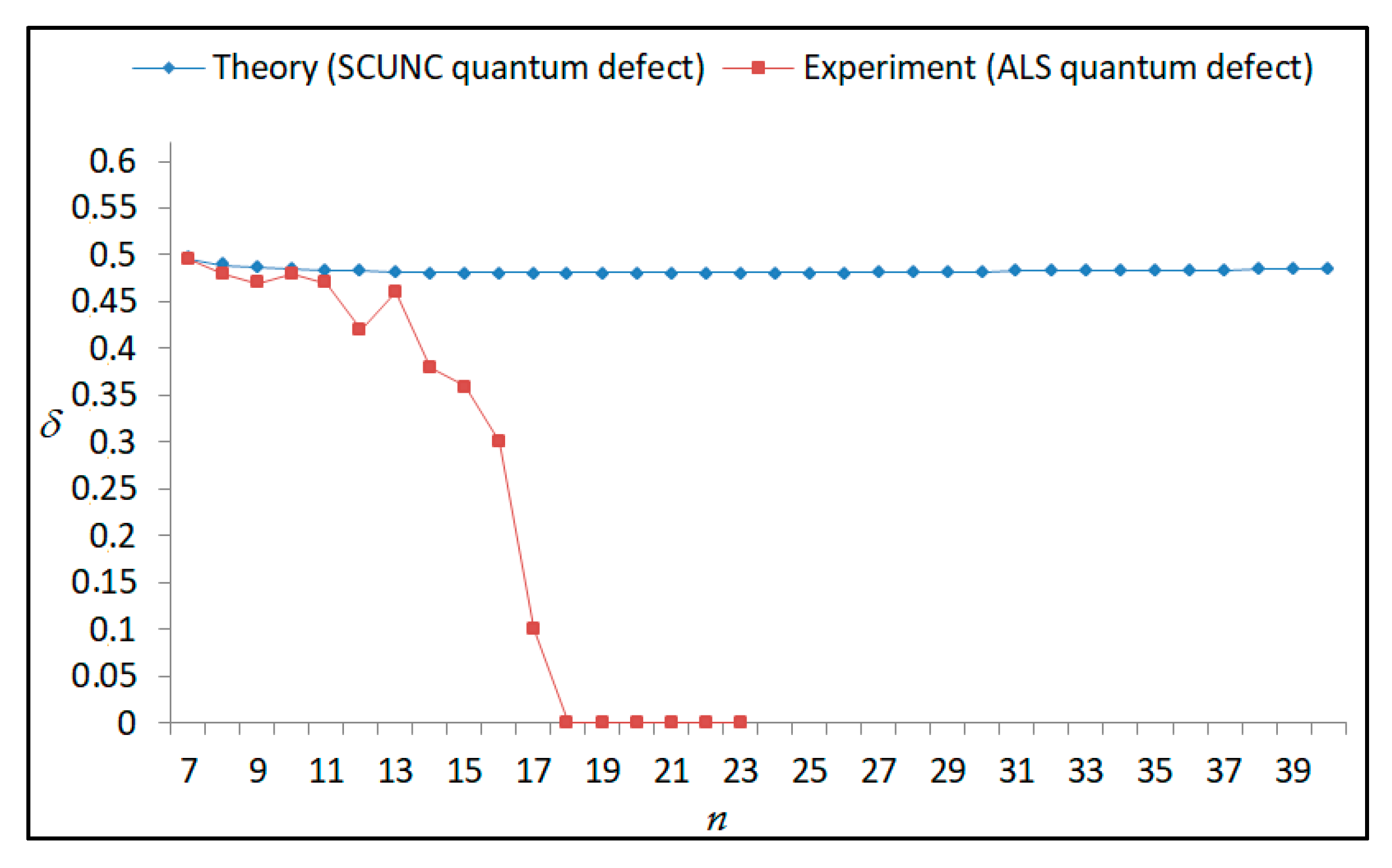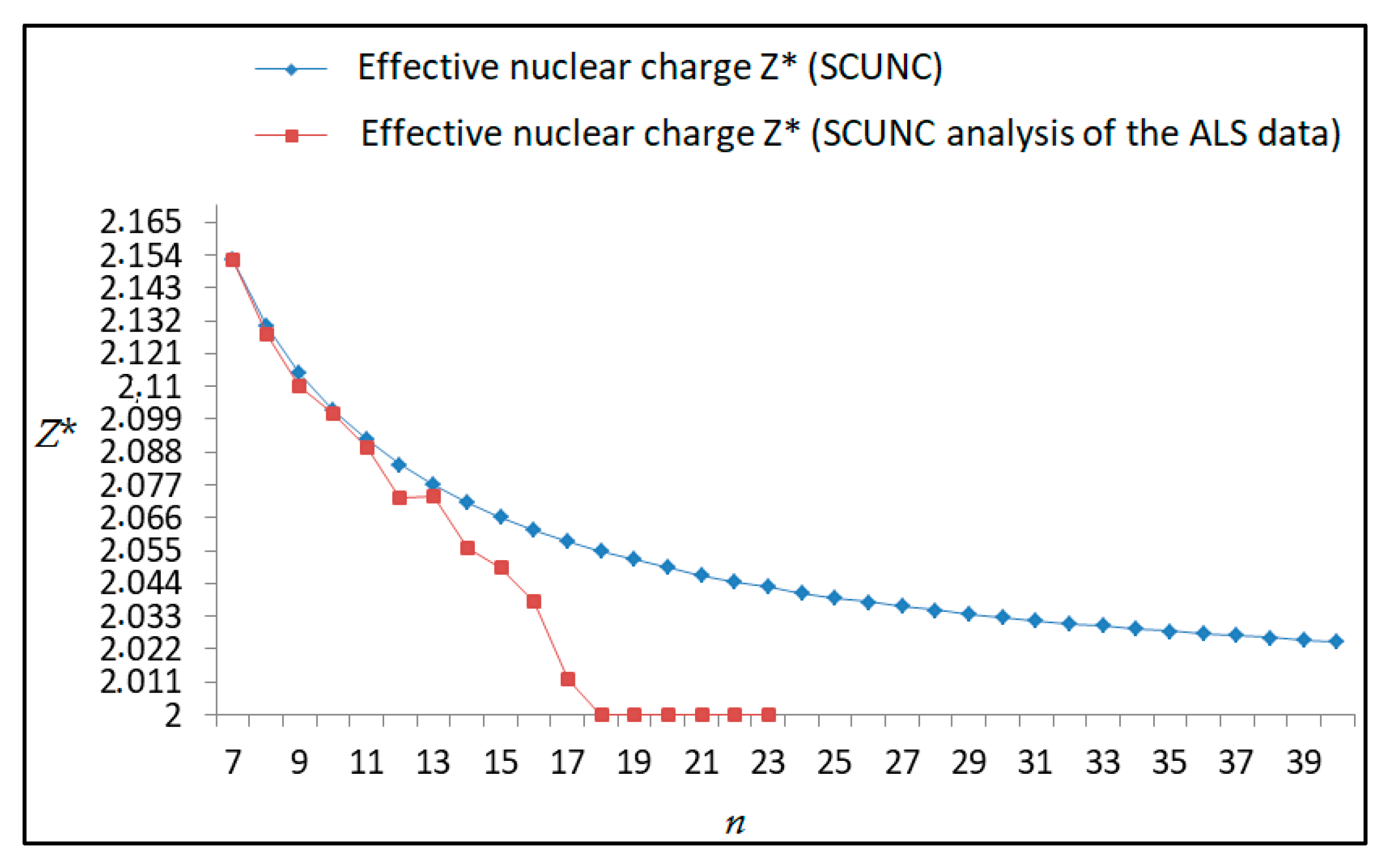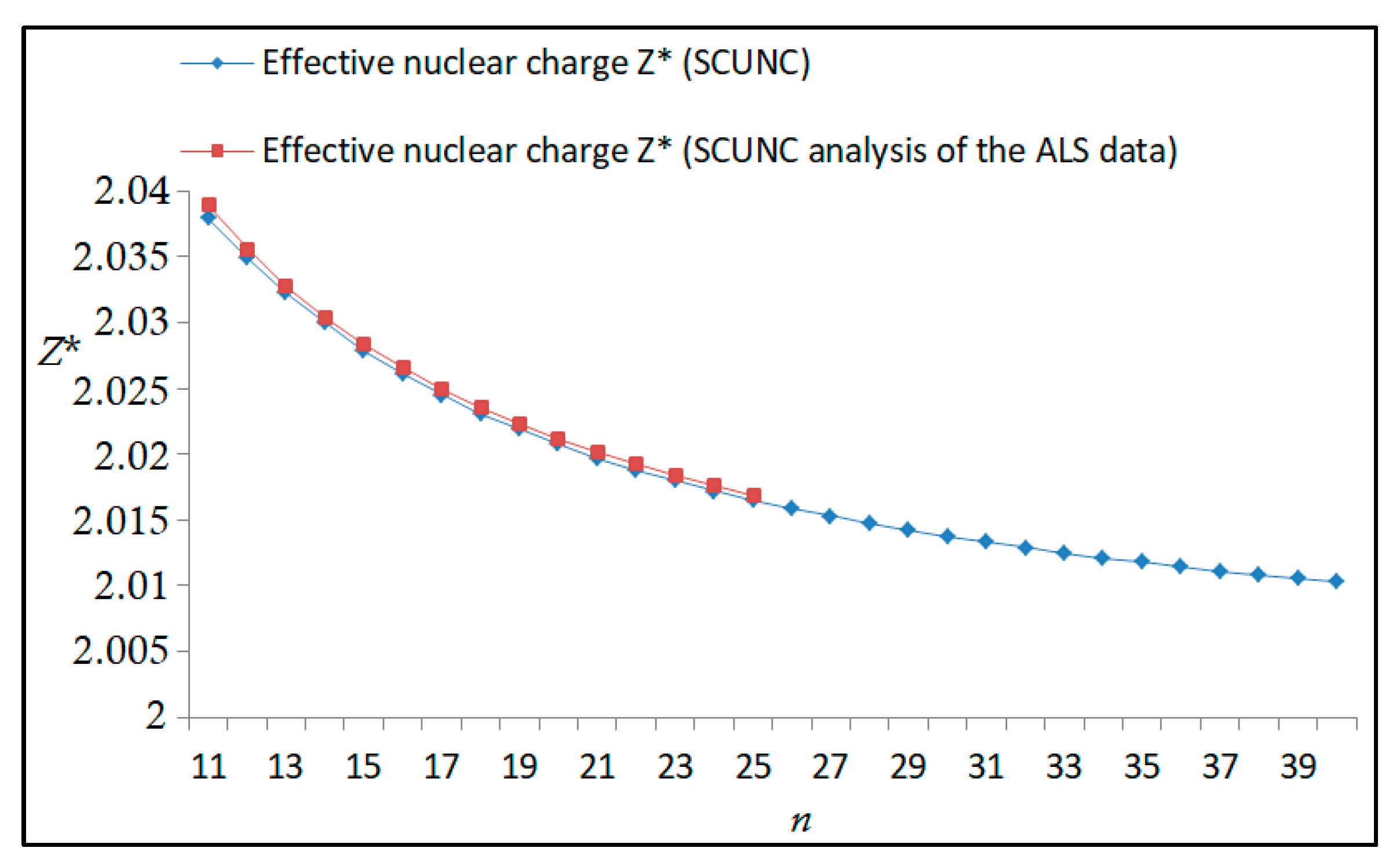The results obtained in this work are listed in
Table 1,
Table 2,
Table 3,
Table 4,
Table 5,
Table 6,
Table 7,
Table 8,
Table 9,
Table 10,
Table 11 and
Table 12 and compared to the ALS measurements [
6]. For all the Rydberg series investigated, the effective nuclear charge
Z* related to the ALS data are evaluated from Equation (7) using the experimental ALS quantum defect.
Table 1 lists the energy resonances, quantum defect and effective charge of the 4
s24
p2 (
1D2)
nd (
2S) Rydberg series originating from the 4
s24
p3 2P°
3/2 metastable state of Se
+ converging to the
1D2 series limit in Se
2+. Comparison indicates excellent agreements between the SCUNC energy resonances and the ALS measurements [
6] up to
n = 15. For these lines, the shift in energy is less than 0.007 eV. However, the same is not true for quantum defect. The SCUNC data are almost constant up to
n = 40, in contrast with the ALS measurements where the quantum defect is equal to zero for
n = 15. This is not allowed, as zero quantum defect is obtained in the case of a pure hydrogenic atomic system. As is well-known, the quantum defect is a quantification of the deviation of the true energy of an excited electron in a Rydberg atom from the hydrogenic model [
6]. In
Figure 1 and
Figure 2, the SCUNC and ALS quantum defects and effective nuclear charges are, respectively, plotted versus the principal quantum number
n. Correct behaviors of the SCUNC quantum defect and nuclear effective charge are obtained.
Table 2 presents the resonances’ parameters evaluated for the 4
s24
p2 (
3P2)
nd Rydberg series originating from the 4
s24
p3 2P°
3/2 metastable state of Se
+ converging to the
3P2 series limits in Se
2+. Here again, the SCUNC and ALS data for energy resonances agree very well. It should be mentioned that the SCUNC formula excellently reproduces the ALS data for
n = 16–22, except for
n = 18, where negative ALS quantum defect equal to –0.080 is obtained. Subsequently, the SCUNC energy at 18.557 eV corresponding to quantum defect equal to 0.039 is preferable to the ALS data equal to 18.560 eV. The details on the behaviors of the SCUNC and ALS quantum defects and effective nuclear charges with increasing the principal quantum number
n are presented in
Figure 3 and
Figure 4, respectively.
Table 3 shows a comparison of the results obtained for the 4
s24
p2 (
3P2)
nd Rydberg series originating from the 4
s24
p3 2P°1/2 metastable state of Se
+ converging to the
3P2 series limits in Se
2+. Here, the SCUNC formula again excellently reproduces the ALS data for
n = 11–13. For
n = 14–18, negative ALS quantum defects are obtained where positive values are allowed, which was also mentioned by Esteves et al. [
6].
Figure 5 and
Figure 6 show the good behaviors of both the quantum defect and effective nuclear charge up to
n = 40. For
n = 14–18, the SCUNC data may be considered as very accurate.
Table 4 shows an excellent agreement between theory and experiment for energy resonances, quantum defect and effective charge of the 4
s24
p2 (
1D2)
ns Rydberg series originating from the 4
s24
p3 2P°3/2 metastable state of Se
+ converging to the
1D2 series limit in Se
2+. The details of these agreements are presented in
Figure 7 and
Figure 8. It should be indicated that analysis of the data with respect to the effective nuclear charge give a best way of evaluating the agreement between theory and experiment, as shown in
Figure 8.
Table 5 indicates a comparison for the SCUNC and ALS energy resonances, quantum defect and effective charge of the 4
s24
p2 (
1D2)
nd(
2P1/2) Rydberg series originating from the 4
s24
p3 2P°1/2 metastable state of Se
+ converging to the
1D2 series limit in Se
2+. For
n = 6-12, the SCUNC energy deviations with respect to the ALS data are less than 0.007 eV. For
n = 13–15, the ALS quantum defect is equal to zero and becomes negative from
n = 14, as shown in
Figure 9. However, for all the series, the SCUNC quantum defect is almost constant up to
n = 40 (see
Figure 9). The SCUNC effective nuclear charge also decreases correctly toward
Zcore = 2.0000 when
n tends toward infinity, as indicated in
Figure 10. It should be underlined that this value is achieved by the ALS measurement for
n = 13. Comparison of the results obtained for the 4
s24
p2 (
1D2)
nd (
2S) Rydberg series originating from the 4
s24
p3 2P°
1/2 metastable state of Se
+ converging to the
3P2 series limit in Se
2+ is performed in
Table 6. Here again, the SCUNC quantum defect is practically constant up to
n = 40, while the ALS quantum defects decrease and become negative for
n = 14–16. Overall, the shift in energy is less than 0.007 eV for the positive ALS quantum defect. For the resonances
n = 14, 15 and 16, the SCUNC energy are, respectively, at 19.674 eV, 19.710 eV and 19.740 eV, and the associated quantum defect is constant and equal to 0.92, which is in contrast with the ALS quantum defects at −0.100, −0.150 and −0.240, respectively. The details regarding the evolution of the quantum defect and the effective nuclear charge are presented in
Figure 11 and
Figure 12, respectively.
Table 7 also indicates negative ALS quantum defects for
n = 14–23 as far as the 4
s24
p2 (
3P2)
nd Rydberg series are concerned. For these series, the SCUNC quantum defect is constant and equal to 0.003 up to
n = 40, as revealed in
Figure 13 and
Figure 14. The SCUNC energy resonances for
n = 14–23 may be very good data references.
Table 8 and
Table 9 list the results obtained, respectively, for the 4
s24
p2 (
1D2)
ns Rydberg series originating from the 4
s24
p3 2P°1/2 metastable state of Se
+ converging to the
1D2 series limit in Se
2+ and for the 4
s24
p2 (
3P2)
nd Rydberg series originating from the 4
s24
p3 2D°3/2 metastable state of Se
+ converging to the
3P2 series limit in Se
2+. For
Table 8, the energy deviation with respect to the ALS data is less than 0.007 eV, attesting to the very good agreement between theory and experiment.
Table 9 shows an excellent agreement between the SCUNC data and the ALS measurements, where the SCUNC reproduces the ALS data, except for
n = 14 and 15, with a shift in energy at 0.001 and 0.002 eV, respectively. The details regarding the behaviors of both quantum defects and effective nuclear charges for the 4
s24
p2 (
1D2)
ns and 4
s24
p2 (
3P2)
nd Rydberg series are presented in
Figure 15 and
Figure 16 for the 4
s24
p2 (
1D2)
ns states and in
Figure 17 and
Figure 18 for the 4
s24
p2 (
3P2)
nd states.
Table 10 and
Table 11 present the results obtained, respectively, for the 4
s24
p2 (
1D2)
ns (
2D) Rydberg series originating from the 4
s24
p3 2D°5/2 metastable state of Se
+ converging to the
1D2 series limit in Se
2+ and the 4
s24
p2 (
1D2)
ns (
2D) Rydberg series originating from the 4
s24
p3 2D°3/2 metastable state of Se
+ converging to the
1D2 series limit in Se
2+. For these data, it is seen that the SCUNC quantum defects are almost constant up to
n = 40, which is in contrast with the ALS quantum defects becoming equal to zero for
n = 18–23, corresponding to an effective nuclear charge at 2.0000 as shown, respectively, in
Figure 19 and
Figure 20. For these resonances, constant SCUNC quantum defects are obtained and equal to 0.490 (
Table 10) and to 0.481 (
Table 11). For the accurate ALS quantum defect more than 0.450, the energy deviations are less than 0.005 eV for the data quoted in both
Table 10 and
Table 11. The details in the accuracy of both quantum defect and effective nuclear charge for the data quoted in
Table 11 are presented in
Figure 21 and
Figure 22. Finally,
Table 12 lists the energy resonances, quantum defect and effective charge of the 4
s24
p2 (
3P2)
nd Rydberg series originating from the 4
s24
p3 4S°
3/2 ground state of Se
+ converging to the
3P2 series limit in Se
2+. Here, the SCUNC formula excellently reproduces the ALS energy resonances except for
n = 12, where the ALS data is at 21.219 eV compared to the accurate SCUNC prediction at 21.291 eV. Using the ALS effective nuclear charge
Z* = 2.0356 from the SCUNC analysis and
E∞ = 21.682 eV, Equation (4) gives the corrected ALS data
E12 = 21,290 eV for the (
3P2)12
d. Subsequently, the ALS data at 21.219 may probably be an error occurring during the typewriting step (it seems that the positions of 1 and 9 have been inverted). As far as quantum defect and effective nuclear charge are concerned, the good agreement between theory and experiment is shown in
Figure 23 and
Figure 24. On the other hand, it should be mentioned that for the 4
s24
p2 (
1D2)
nd (
2D) and 4
s24
p2 (
1D2)
ns (
2D) and of the 4
s24
p2 (
1D2)
nd (
2S) and 4
s24
p2 (
1D2)
nd (
2P1/2) Rydberg series, the ALS data overlap. As shown in
Table 5 and
Table 6, the ALS data for the two levels 4
s24
p2 (
1D2)12
d(
2P1/2) and 4
s24
p2 (
1D2)12
d (
2S) are equal to 19.571 eV, with a quantum defect at 0.100. In the same way, the levels 4
s24
p2 (
1D2)18
d(
2P1/2) and 4
s24
p2 (
1D2)18
d (
2S) are equal to 19.718 eV, with a negative quantum defect at −0.150. For these overlap lines, the SCUNC predicts separate levels associated with the energies 19.556 eV and 19.571 eV, respectively, for the 4
s24
p2 (
1D2)12
d(
2P1/2) and 4
s24
p2 (
1D2)12
d (
2S) levels. The corresponding quantum defects are at 0.169 and 0.093, respectively. As a result, the 19.571 eV ALS data may be for the 4
s24
p2 (
1D2)12
d (
2S) level and not for 4
s24
p2 (
1D2)12
d(
2P1/2). In addition, the SCUNC predictions for the 4
s24
p2 (
1D2)18
d(
2P1/2) and 4
s24
p2 (
1D2)18
d (
2S) levels are at 19.708 eV and 19.710 eV, respectively. The ALS data at 19.718 eV associated with a negative quantum defect at –0.150 may be uncertain. As explained by Esteves et al. [
6], some resonances in the ALS analysis have not been resolved, either due to interference from other series or to limitations in photon energy resolution at high
n values. In addition, McLaughlin and Balance [
7] have shown in their works how the presence of interloping resonances disrupt the regular Rydberg pattern of the resonances. Probable strong coupling series occur in the photoionization processes of the Se
+ ions. Anyway, the overlapping ALS lines and the negative quantum defects measured may be explained by the interference from other series, causing strong interseries coupling and/or limitations in photon energy resolution at high
n values. In the SCUNC predictions, these narrow lines are clearly identified. The constant behavior of
δ along all the series may indicate that the probable strong interseries perturbations due to interference between series has no effect on the fitting parameters
f1 and
f2. This may demonstrate the stability of Equations (12)–(14) and, subsequently, the utility of the SCUNC formalism to separately identify high-lying narrow interfering series. On the other hand, before closing the discussion section, it is interesting to remind one what the main advantages of using the SCUNC method are. For the various techniques of calculations applied in atomic physics, the
R-matrix approach is seen to be the most sophisticated and widely used method [
22]. As pointed out by McLaughlin and Ballance [
7], in
R-matrix theory, all photoionization (PI) cross-section calculations require the generation of atomic orbitals based primarily on the atomic structure of the residual ion. In their works, the PI of the Se
+ ions employs relativistic atomic orbitals generated for the residual Se
2+ ions which were calculated using the extended-optimal-level (EOL) procedure within the GRASP structure code. In addition, to calculate the direct photoionization cross-sections in these experiments, Bizau et al. [
23] performed the multiconfiguration Dirac-Fock (MCDF) calculations using the code developed by Bruneau [
24]. These particular examples indicate that calculations or experiments based on PI cross-section studies require at least:
